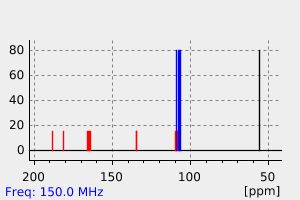lunatin
中文名称
——
中文别名
——
英文名称
lunatin
英文别名
1,3,8-Trihydroxy-6-methoxyanthracene-9,10-dione
CAS
——
化学式
C15H10O6
mdl
——
分子量
286.241
InChiKey
DGZZHABEBFUFSC-UHFFFAOYSA-N
BEILSTEIN
——
EINECS
——
-
物化性质
-
计算性质
-
ADMET
-
安全信息
-
SDS
-
制备方法与用途
-
上下游信息
-
文献信息
-
表征谱图
-
同类化合物
-
相关功能分类
-
相关结构分类
计算性质
-
辛醇/水分配系数(LogP):2.3
-
重原子数:21
-
可旋转键数:1
-
环数:3.0
-
sp3杂化的碳原子比例:0.07
-
拓扑面积:104
-
氢给体数:3
-
氢受体数:6
上下游信息
-
下游产品
中文名称 英文名称 CAS号 化学式 分子量 —— 1,8-dihydroxy-3-methoxyanthracene-9,10-dione 57754-80-0 C15H10O5 270.241
反应信息
-
作为反应物:描述:lunatin 在 glucose dehydrogenase 、 sodium dithionite 、 乙二胺四乙酸 、 葡萄糖 、 硫酸 、 dithiothreitol 、 烟酰胺腺嘌呤双核苷酸磷酸盐 作用下, 以 甲醇 、 aq. phosphate buffer 、 二甲基亚砜 为溶剂, 反应 24.0h, 生成 1,8-dihydroxy-3-methoxyanthracene-9,10-dione参考文献:名称:A biocatalytic approach towards the preparation of natural deoxyanthraquinones and their impact on cellular viability摘要:使用化学酶法合成的天然脱氧蒽醌,经过细胞存活性测试显示与相应的蒽醌相比毒性较低。DOI:10.1039/d1nj05513e
-
作为产物:参考文献:名称:Eder; Hauser, Helvetica Chimica Acta, 1925, vol. 8, p. 143摘要:DOI:
文献信息
-
Monomeric Dihydroanthraquinones: A Chemoenzymatic Approach and its (Bio)synthetic Implications for Bisanthraquinones作者:Nirmal Saha、Amit Mondal、Karina Witte、Shailesh Kumar Singh、Michael Müller、Syed Masood HusainDOI:10.1002/chem.201705998日期:2018.1.26by a biomimetic and chemoenzymatic approach using NADPH‐dependent polyhydroxyanthracence reductase (PHAR) from Cochliobolus lunatus followed by Pb(OAc)4 oxidation is reported. Subsequent dimerization through a hetero‐Diels–Alder reaction of the dihydroemodin and dihydrolunatin resulted in (−)‐flavoskyrin (68 %) and (−)‐lunaskyrin (62 %), respectively. Pyridine treatment of (−)‐flavoskyrin and (−)‐lunaskyrin修饰的双蒽醌是具有笼状结构基序的复杂的二聚体天然产物。对于其生物合成,单体二氢蒽醌已被提议作为关键中间体,尽管还没有从天然来源中分离出来或迄今仍未合成。在这里,通过仿生和化学酶学方法,使用Cochliobolus lunatus的NADPH依赖的多羟基蒽还原酶(PHAR),然后用Pb(OAc)4进行仿生和化学酶学方法合成的二氢大黄素以及二氢大黄素的分离和表征据报道氧化。随后通过二氢大黄素和二氢伦丁的异狄尔斯-阿尔德反应进行二聚,分别导致(-)-黄酮丁草酯(68%)和(-)-氟那斯基林(62%)。吡啶处理(−)‐ flavoskyrin和(−)‐ lunaskyrin的处理使(−)‐ rugulosin和(−)‐ 2,2'- Epi- cytoskyrinrin A的级联反应分别产生64%和60%二聚体中间体。讨论了所描述的合成对通过酶促和自发步骤的组合生物合成双蒽醌的影响。
-
A Biomimetic Synthesis of Racemic Dihydroanthracen-1(2<i>H</i> )-ones Using Sodium Borohydride in Water作者:Amit Mondal、Shailesh Kumar Singh、Nirmal Saha、Syed Masood HusainDOI:10.1002/ejoc.202000096日期:2020.5.3We report a first synthesis of racemic dihydroanthracenones through regioselective reduction of hydroanthraquinones using NaBH4 in water. Their use confirms the enantiopurity of chiral dihydroanthracenones synthesized chemoenzymatically and of the bisanthraquinone analogues.
-
Identification and characterization of an anthrol reductase from <i>Talaromyces islandicus</i> (<i>Penicillium islandicum</i>) WF-38-12作者:Shailesh Kumar Singh、Amit Mondal、Nirmal Saha、Syed Masood HusainDOI:10.1039/c9gc03072g日期:——oxidoreductase from Talaromyces islandicus WF-38-12 has been identified through genome analysis. It has been shown to catalyze a regio- and stereoselective reduction of anthrols (formed in situ by the reduction of anthraquinones in the presence of Na2S2O4) to (R)-dihydroanthracenones, with high enantiomeric excess (>99%). The implications of results on the biosynthesis of deoxygenated (bis)anthraquinones and
-
Promiscuity of an unrelated anthrol reductase of <i>Talaromyces islandicus</i> WF-38-12作者:Shailesh Kumar Singh、Anshul Rajput、Arijit De、Tapati Chakraborti、Syed Masood HusainDOI:10.1039/d0cy02148b日期:——
A new anthrol reductase from
Talaromyces islandicus (ARti-2).一种来自冰岛塔拉罗米切斯(Talaromyces islandicus)的新的蒽醌还原酶(ARti-2)。 -
Synthesis of (−)-Flavoskyrins by Catalyst-Free Oxidation of (<i>R</i>)-Configured Dihydroanthracenones in Aqueous Media and Its (Bio)synthetic Implications作者:Amit Mondal、Arijit De、Syed Masood HusainDOI:10.1021/acs.orglett.0c03121日期:2020.11.6A catalyst-free method for the synthesis of dimeric (-)-flavoskyrins has been developed. It involves the autoxidation of chemoenzymatically synthesized (R)-configured dihydroanthracenones in the presence of molecular oxygen in buffer of pH 6.0 followed by spontaneous [4 + 2] cycloaddition in stereocontrolled exo-anti fashion to form (-)-flavoskyrins. The method is applied to obtain several homo- as well as heterodimerized flavoskyrins (nine examples) in 27-72% yield and implies the involvement of a similar pathway in the (bio)synthesis of modified bisanthraquinones and their analogues.
表征谱图
-
氢谱1HNMR
-
质谱MS
-
碳谱13CNMR
-
红外IR
-
拉曼Raman
-
峰位数据
-
峰位匹配
-
表征信息
同类化合物
齐斯托醌
黄决明素
马普替林相关物质D
马普替林杂质E(N-甲基马普替林)
马普替林杂质D
马普替林D3
马普替林
颜料黄199
颜料黄147
颜料黄123
颜料黄108
颜料红89
颜料红85
颜料红251
颜料红177
颜料紫27
顺式-1-(9-蒽基)-2-硝基乙烯
阿美蒽醌
阳离子蓝FGL
阳离子蓝3RL
长蠕孢素
镁蒽四氢呋喃络合物
镁蒽
锈色洋地黄醌醇
锂钠2-[[4-[[3-[(4-氨基-9,10-二氧代-3-磺基-1-蒽基)氨基]-2,2-二甲基-丙基]氨基]-6-氯-1,3,5-三嗪-2-基]氨基]苯-1,4-二磺酸酯
锂胭脂红
链蠕孢素
铷离子载体I
铝洋红
铂(2+)二氯化1-({2-[(2-氨基乙基)氨基]乙基}氨基)蒽-9,10-二酮(1:1)
钾6,11-二氧代-6,11-二氢-1H-蒽并[1,2-d][1,2,3]三唑-4-磺酸酯
钠alpha-(丙烯酰氨基)-[4-[[9,10-二氢-4-(异丙基氨基)-9,10-二氧代-1-蒽基]氨基]苯氧基]甲苯磺酸盐
钠[[3-[[4-(环己基氨基)-9,10-二氢-9,10-二氧代-1-蒽基]氨基]-1-氧代丙基]氨基]苯磺酸盐
钠[3-[[9,10-二氢-4-(异丙基氨基)-9,10-二氧代-1-蒽基]氨基]丁基]苯磺酸盐
钠6,11-二氧代-6,11-二氢-1H-蒽并[1,2-d][1,2,3]三唑-4-磺酸酯
钠4-({4-[乙酰基(乙基)氨基]苯基}氨基)-1-氨基-9,10-二氧代-9,10-二氢-2-蒽磺酸酯
钠2-[(4-氨基-9,10-二氧代-3-磺基-9,10-二氢-1-蒽基)氨基]-4-{[2-(磺基氧基)乙基]磺酰基}苯甲酸酯
钠1-氨基-9,10-二氢-4-[[4-(1,1-二甲基乙基)-2-甲基苯基]氨基]-9,10-二氧代蒽-2-磺酸盐
钠1-氨基-4-[(3-{[(4-甲基苯基)磺酰基]氨基}苯基)氨基]-9,10-二氧代-9,10-二氢-2-蒽磺酸酯
钠1-氨基-4-[(3,4-二甲基苯基)氨基]-9,10-二氧代-9,10-二氢-2-蒽磺酸酯
钠1-氨基-4-(1,3-苯并噻唑-2-基硫基)-9,10-二氧代蒽-2-磺酸盐
醌茜隐色体
醌茜素
酸性蓝P-RLS
酸性蓝41
酸性蓝27
酸性蓝127:1
酸性紫48
酸性紫43
酸性兰62







